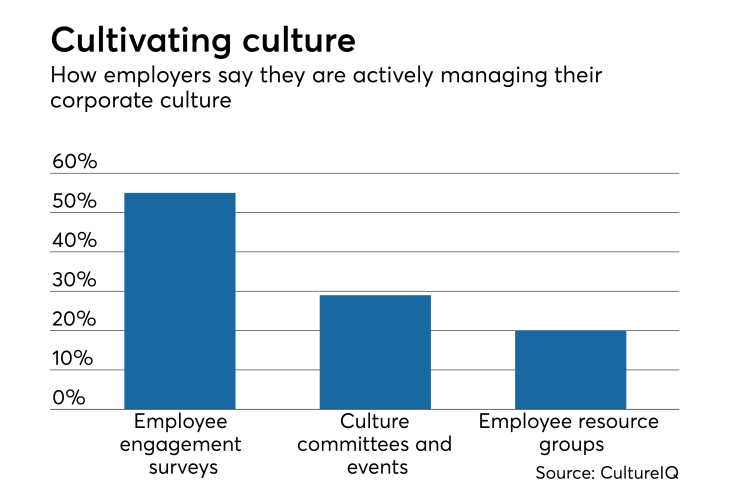Company culture can improve productivity and profitability in an organization, yet many companies struggle to get leadership on board to assign time and resources to develop it, according to new research from CultureIQ, a New York-based HR software company.
More than half (56%) of employers say they are unable to actively manage culture because they lack leadership support, while 45% say they don’t have enough time or resources, according to the company’s “Employee Culture: A Closer Look” study, done in conjunction with HR.com.
“Senior leadership involvement tends to be the largest barrier on acting on culture,” says David Shanklin, head of culture strategy at CultureIQ. “Frontline managers can only do so much. If they don’t ultimately have senior leader buy-in, it can be challenging.”

In fact, about 52% of organizations believe that leadership buy-in is the biggest obstacle to strengthening a company’s culture, whereas 83% identified executive leadership as the driver of company culture, according to the report.
Without C-suite leadership instilling company culture, the onus falls on managers and mid-level employees.
“On the softer side, it’s harder to give what you’re not getting yourself,” Shanklin says. “On the more tactical side, what organizations need to commit to when they undertake a real solid effort on culture is aligning the businesses processes on the culture you're trying to drive.”
For example, HR managers should work with executives to find out what drives employee engagement. The most popular methods to actively manage company culture and drive employee engagement, according to the survey, are: drafting employee engagement surveys (55%), creating culture committees and events (29%) and offering employee resource groups (20%).
Employees, on the other hand, expect to be led by example and have C-suite define and promote the workplace culture, according to the report.
Shanklin says the best thing for employers to do is be explicit about what behaviors are valued and what it takes to get work done at the company.
See also:
“The most important thing companies can do is be transparent and be upfront about what the culture is and what it’s like to work there,” he says. “You should know when you step foot in an organization if it’s right for you.”
Companies with a strong workplace culture also correlates to profitability and productivity, according to the report.
More than seven in 10 HR professionals (73%) said corporate culture drives competitive advantage for their company, yet only 33% believe their company is in the top 25% of their peers ranked by profitability, according to the “Employee Culture: A Closer Look” study. “This reveals a gap between what is perceived as important and what is being done in an organization to drive a positive culture, and thereby profitability.”
For companies with top corporate culture, as determined by another CultureIQ study that polled 28,371 employees at 340 companies, leadership was the key differentiator.
Nearly nine in 10 (89%) of the top 50 companies with “winning cultures” were more likely to report that the company stays true to its
Similarly, 86% of the top companies said that senior leadership listens to employees, compared to 70% of the others, according to the report. Seventy-one percent of top companies added that employees question the status quo, compared to 53%.
The latter statement, the reports argues, “encompasses a few cultural aspects of an organization. First, it points to the overall feeling of continuous improvement. In organizations that question the status quo, leaders must promote behaviors that drive creativity and
innovation, such as taking risks, learning from mistakes and adapting to opportunities as they arise.”
Shanklin says a mentor of his likens company culture to spicy food: one taste and an employee should know whether it’s for them. He also recognizes that leadership needs to be strategic in creating a company culture that offers an instantaneous feel, similar to a bite of spicy food.
“It's not about





